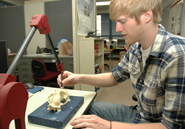Engineering research could help describe extinct animals' behaviors

Eric Tobaben, Topeka, is a first-year graduate student in mechanical engineering at KU.
LAWRENCE — A student at the University of Kansas School of Engineering has taken the first steps that could unlock new details about how extinct animals lived and hunted on a daily basis.
Eric Tobaben, now a first-year graduate student in mechanical engineering at KU, conducted research as an undergraduate student in the biomechanics lab of Ken Fischer, associate professor of mechanical engineering. Tobaben, of Topeka, created dozens of digital models of animal skulls, from lions and tigers to bobcats and house cats. His efforts were aimed at identifying the typical head orientation for each animal.
"By determining the natural head angle, you define the posture the animal would have had in a relaxed condition," Tobaben said. "From there, you can pick up behavioral cues that can reveal how these animals lived."
The work digitizing skulls began with those already on hand at KU's Natural History Museum. Tobaben and Fischer hope the initial research produces findings that show enough promise to expand their efforts.
"The real key is to establish a fundamental relationship between the optical nerve opening and the center of the eye socket. That would allow us to define a line of sight based on skull shape, and once you have that determined, you can make a link back to extinct animals," Fischer said. "The key hypothesis is that for most animals the natural line of sight will be in a horizontal plane. By studying modern animals we can work to verify that principle, and if it holds true, that's where the real power of this research lies."
Establishing optic nerve position and line of sight details involves securing each skull within the reach of a digitizing device capable of recording three-dimensional positions. Tobaben, whose research earned him the nickname "Skully" from his lab partners, used the device stylus to record hundreds of points of the features and surface of each skull. Tobaben then used a computer program to visualize and analyze the three-dimensional skull data.
"It's fun to put all those points into a program and see the image materialize," Tobaben said. "You can wrap the points with skin and suddenly you have a whole skull, and you can get a good feel for how accurate it is by matching it up to pictures of existing animals."
Fischer and Tobaben are working to publish the results of the skull studies in hopes of obtaining funding to take the research into new areas.
"Once we get the publication submitted, we will send a grant application to the National Science Foundation. We hope to obtain funding to continue and expand the work into a more broad range of species and delve into extinct species as well,"
Fischer said. "It's exciting work with a lot of potential, and we're looking forward to what the future holds."